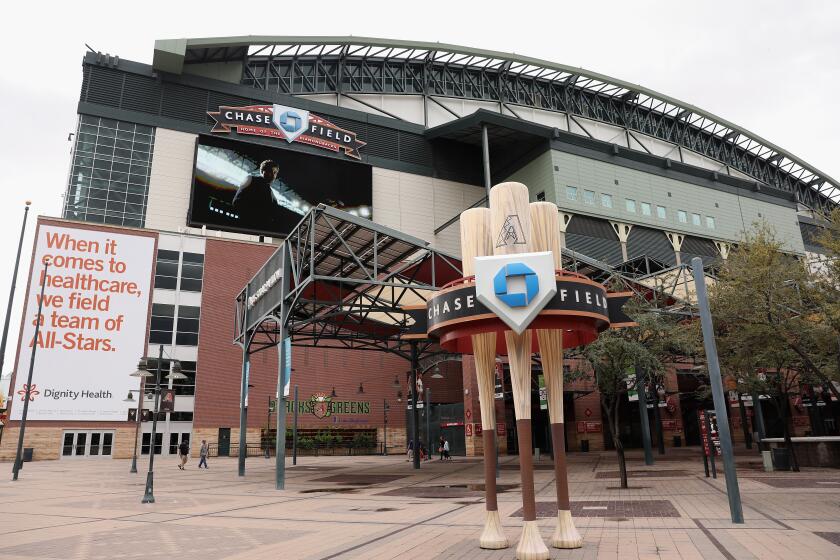Terry Cannon, founder of the quirky Pasadena-based Baseball Reliquary, dies at 66
- Share via
In 1951, Eddie Gaedel made his one and only appearance as a major league baseball player. He stepped to bat for the St. Louis Browns, all 3-foot-7 of him, the shortest player in the history of the league. He walked, of course, because his strike zone was all but nonexistent.
The National Baseball Hall of Fame includes among its vast collections the jersey Gaedel wore that day, with the uniform number 1/8. The Baseball Reliquary has the athletic supporter Gaedel wore.
“That is a very treasured item,” said Mary Cannon, the artistic director of the Reliquary. “People take their picture with it.”
Terry Cannon, her husband, founded the Reliquary to preserve and to share the spirit of a sport commonly defined by statistics. Terry Cannon died Aug. 1 at his Pasadena home; he was 66. The cause of death was bile duct cancer, Mary Cannon said.
By trade, Terry Cannon was a librarian. In 1975, he launched a festival of experimental film that now has outlived him. He was a jazz aficionado who commissioned a suite to celebrate the life of Jackie Robinson. He published a series of journals, one of which included an essay from his wife entitled “Why I Hated Baseball.”
In the wake of coronavirus outbreaks that have interrupted the season for three teams, MLB is considering whether to move the postseason into a bubble.
Over the decades, Mary Cannon grew to love the sport, or at least the collection of artifacts Terry housed in the family living room, in the converted card catalogs in another room, in the garage, and in a storage unit.
“I was interested in the things that other museums weren’t interested in collecting, like if they wanted bats and gloves, I wanted things that kept famous stories alive,” Terry Cannon told Pasadena Weekly in 2017. “It was more interesting to find a desiccated hot dog that Babe Ruth partially digested than a signed baseball or bat.”
The term “reliquary” is defined as a collection of holy relics. Cannon’s collection included the aforementioned Babe Ruth hot dog, a tortilla bearing the face of former Dodgers owner Walter O’Malley, and a baseball-shaped potato that an enterprising minor league catcher actually used to pick a runner off third base.
“He heralded the rebels and the mavericks and the eccentrics in baseball,” said Occidental College professor Peter Dreier, a friend of Cannon. “He loved the game of baseball. He didn’t really have much love of the business of baseball.”
In 1999, Cannon expanded the Reliquary by launching what he called the “Shrine of the Eternals,” a cheeky answer to the Hall of Fame. The first induction class included Dock Ellis, an All-Star pitcher perhaps best known for saying he pitched a no-hitter under the influence of LSD.
“He was a brilliant pitcher and a strange dude,” Dreier said. “He shows up and he starts crying. Somebody had appreciated him, and he didn’t have to compromise who he was.”
Two years later, the inductees included Jim Bouton, the pitcher whose landmark book “Ball Four” lifted the veil of mythology around baseball players and portrayed them as humans who sometimes skipped signing autographs, had too much to drink, and did not always honor their marital vows. When the book was published in 1970, Bouton instantly became a baseball outcast.
When Cannon called to inform him of his election to the Shrine of the Eternals, Bouton provided Cannon with a nickname that stuck.
“The people’s hall of fame,” Bouton told Cannon.
The election process was entirely democratic: Anyone could nominate, anyone could vote, and anyone could join the hundreds that rang cowbells at the annual induction ceremony.
“Terry wasn’t in this for anything except spreading his love of the game, and bringing together people who love baseball,” said longtime Southern California sportswriter Lisa Nehus Saxon, whom Cannon invited to speak on several occasions. “He wasn’t about fuss and fanfare by any means.
“He was just a force of nature. He put every ounce of his energy into this passion project.”
A look at some of the greatest moments in sports history to occur on Aug. 12.
Cannon’s collection will reside at the Institute of Baseball Studies, based at Whittier College. His wife is getting a plaque made of her husband, just like the ones he used to present to inductees.
“That will be my treasure,” she said.
And, along the way, the so-called “people’s hall of fame” grew to command the respect of baseball’s official hall of fame.
“Terry took his passion and created a unique format, sharing and educating fans not only about the game, but also its importance and value culturally within society,” National Baseball Hall of Fame president Tim Mead said. “His criteria for election into the Shrine of the Eternals reminds us that impactful and memorable contributions to the game occur in a variety of means.
“The story of baseball is a collection of legendary moments and endless accounts, shared from countless perspectives and authored by thousands of contributors. There will always be room for those who share similar passions to educate others. In the end, for both Terry and the Hall of Fame, it is a celebration of the game of baseball.”
More to Read
Go beyond the scoreboard
Get the latest on L.A.'s teams in the daily Sports Report newsletter.
You may occasionally receive promotional content from the Los Angeles Times.













